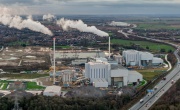Circular wind farms offer a path to meeting UK clean energy targets
EMR argues that repowering turbines through upgrading and recycling can mitigate the risks to onshore wind capacity, as Renewable Obligation Scheme payments reach end.
 With over 9GW of onshore wind capacity at risk by 2040, metal recycling firm, EMR, argues that ‘repowering’ and circular reuse is vital to meet the UK’s Clean Power 2030 targets, which include a doubling of onshore wind capacity within the next five years.
With over 9GW of onshore wind capacity at risk by 2040, metal recycling firm, EMR, argues that ‘repowering’ and circular reuse is vital to meet the UK’s Clean Power 2030 targets, which include a doubling of onshore wind capacity within the next five years.
While new wind projects are held back by planning delays, grid constraints, and rising costs, thousands of older turbines installed under the Renewables Obligation (RO) scheme are nearing the end of their supported lifespan.
The scheme, which required electricity suppliers to source an increasing amount of their electricity from renewable sources, closed to new entrants in 2017. Support for early entrants is set to expire in 2027, leaving many of the country’s first wind farms with an uncertain future.
In this stage of decommissioning, EMR is calling for a coordinated approach to repowering - the process of upgrading or replacing existing wind turbines with modern, high-capacity models.
As early wind farms are built in prime locations, the firm argues that repowering could triple electricity output while reducing the number of turbines required, based on similar cases in Europe.
Charlotte Stamper, Strategic Partnerships Manager at EMR, commented: “Significant numbers of UK onshore wind turbines are heading into their twilight years. We now have the technology to replace them with newer models that generate much more green electricity, as well as being able to create a circular economy for the valuable and strategically important materials that the old turbines contain.”
Analysis from the Institute for Public Policy Research has also suggested that acquiring and repowering ageing assets could deliver up to five per cent of national electricity needs by the early 2030s.
Remanufacturing components such as nacelles, gearboxes, and generators allows older parts of the turbine to be restored to original specification, extending the lifecycle of the equipment.
Alternatively, recycling processes for many key materials, such as steel, copper, aluminium, and concrete allows these materials to be used in other sectors, like the construction industry.
Stamper added: “Without a credible plan for renewing/repowering these older turbines, we risk sleeping on our Clean Power 30 targets.”
EMR Wind Turbine Processing Centre in Glasgow is one facility that is using the repowering model. The centre dismantles old turbines and assesses each component for reuse, remanufacturing or recycling.
Through its partnership with HyProMag, ORE Catapult, Magnomatics, and the University of Birmingham, EMR is aiming to deliver a scaled-up circular supply chain that keeps critical resources, such as rare earth magnets, within the UK economy.







